Final report for OS21-140
Project Information
To combat heavy reliance on synthetic insecticides among conventional growers, and improve pest management options for organic growers, this project aims to evaluate the potential for biological control with beneficial entomopathogenic nematodes (EPNs) to help manage cucumber beetles and other pests of cucurbit crops. Biological control using EPNs can be part of an effective strategy for controlling many soil-dwelling insect pests, including cucumber beetles. However, despite promising results from previous studies, EPN biological control is still not widely used in U.S. agriculture and represents only a small fraction (about 0.03%) of the U.S. pest control market, indicating a critical need for continued research into EPN-based biocontrol strategies, as well as education and outreach to encourage greater use among U.S. producers. Research from our lab has revealed that applications of EPNs to plant roots can directly boost plant resistance to a variety of insect pests and pathogens, which suggests that growers can receive multiple benefits from EPN biological control, as EPNs both directly kill pest insects and boost plant resistance. We hypothesized that introducing EPNs would reduce insect damage and boost yield of cucurbit crops through two mechanisms, including both direct mortality of cucumber beetle larvae by EPNs and increased plant resistance against pests following plant exposure to EPNs. Furthermore, because EPNs were only be applied to soil near roots, we predicted that they would not reduce numbers of beneficial insects visiting plants. We evaluated EPN introductions for 3 different cucurbit crops, including cucumbers (Cucumis sativus), summer squash (Cucurbita pepo), and watermelon (Citrullus lanatus) in 2021 and bitter melon (Momordica charantia) in 2022. Overall, we found some evidence of reduced damage and increased yields for plants treated with EPNs. We did not observe differences in numbers of beneficial insects, suggesting EPN treatments did not harm pollinator or natural enemy populations. This research provided new insights into pest management for 3 important crops for our cooperator and the U.S. cucurbit market, and is likely to benefit growers on diversified farms seeking better management options.
Project Objectives
We evaluated the potential for entomopathogenic nematodes (EPNs) to provide biological control and boost plant resistance to improve pest management in cucurbit crops following two specific objectives:
- Determine the effectiveness of EPN biocontrol in cucurbit crops for reducing numbers of pest insects and plant damage, while preserving beneficial insect populations.
- Assess how introducing EPNs affects plant growth and yield.
Cooperators
- - Producer
Research
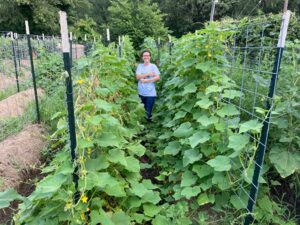
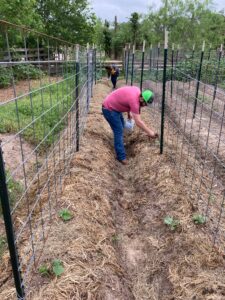
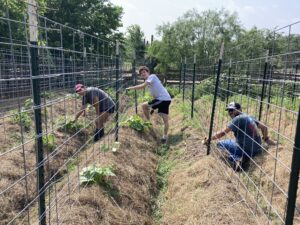
Materials and Methods
This project was conducted at Ronin Farm, which is a 15-acre diversified vegetable farm located in Bryan, TX. This project was developed in close collaboration with the owner, Mr. Brian Light, who expressed strong interest in improving pest management on his farm through sustainable strategies and incorporating biological control with beneficial nematodes as part of his management plan. Mr. Light selected the plant varieties for this project based on previous experience with produce quality and plant performance in Brazos county, TX. The entomopathogenic nematodes selected for this project are Heterorhabditis bacteriophora and Steinernema riobrave, which are suitable for southern climates and cucumber beetle control (Arbico Organics, USA).
This project was conducted over two field seasons in 2021 and 2022, using a randomized complete block design, based on a previous EPN study (Ellers-Kirk et al., 2000). Each block was divided into 2 rows and each row received one treatment: 1) plants treated with EPNs and 2) untreated control plants. Blocks were replicated 4 times each for cucumbers, watermelon or bitter melon, and summer squash. Our plots were planted in April of each year (4/20/21 and 4/27/22) and plants were grown and maintained following typical cultivation practices on Ronin Farm. Seeds were planted directly into raised rows and thinned as needed. For cucumber and bitter gourd, we planted ~4 m long rows with 10 plants each, spaced 30 cm apart. For watermelons, we planted ~9 m long rows with 5 plants each, spaced 1.5 m apart. For Summer squash, we planted ~7 m long rows with 10 plants each, spaced 60 cm apart. Crops were adjacent, and all rows were 1 m apart. Cucumber and bitter gourd vines were trained onto trellises to promote airflow to leaves and facilitate easier surveys and harvest. Rows were covered with straw mulch to suppress weeds and retain moisture and plants were irrigated as needed.
EPN treatments were applied twice per year to trigger plant resistance and target soil-dwelling pests like cucumber beetles. Plants were treated with EPNs at 1 true leaf (~2 weeks after planting) and when they began to flower and set fruit (~6 weeks). Each treatment plant received ~200,000 free-living EPNs in 100 mL water and control plants each received 100 mL water added to soil at the plant base.
Insect surveys and damage assessments
To quantify numbers of pest insects, we conducted weekly visual surveys of all experiment plants from germination until final harvest (Skidmore et al., 2019). Each plant was observed for 60 seconds to search for insects. If detected, insects were sight identified (to species, family, or order as possible) and counted. Examples of insects in surveys included striped (Acalymma vittatum), spotted (Diabrotica undecimpunctata howardi), and banded (Diabrotica balteata) cucumber beetles, melon aphids (Aphis gossypii), squash bugs (Anasa tristis), squash vine borers (Melittia cucurbitae), leaf footed bugs (Leptoglossus zonatus), and silverleaf whiteflies (Bemisia tabaci). We also assessed cucumber beetle control using traps to monitor adult beetle emergence from soil. Traps (25 cm2, 12 cm tall) were placed on the soil surface between plants in each row (4 per row for each plant species) 5 weeks after planting, allowing time for any adult beetles to lay eggs, and were monitored twice weekly for 4 weeks (Ellers-Kirk et al., 2000).
During surveys, we also quantified numbers of beneficial insects present on plants to determine whether EPN introductions influenced the beneficial insect community. Examples of insects surveyed (sight identification) included pollinators like honey bees (Apis mellifera), squash bees (Peponapis pruinosa), and other native bees (Osmia, Agapostemon, Bombus, Megachile sp., etc.), as well as natural enemies like wasps (e.g. Ichneumonidae, Braconidae, Vespidae, etc.), flies (Syrphidae), and beetles (e.g. Coccinellidae, Carabidae, etc.).
In separate weekly surveys, we estimated % damage (insect or pathogen) area on leaves, flowers, and fruits.
Plant growth and yield data
To determine the effects of EPN introduction on plant biomass, we quantified root length density following previously described methods (Ellers-Kirk et al., 2000). Briefly, soil cores were taken near plant stems during the final week of harvest and cm root length per mm soil was calculated. This was replicated three times per row for each plant species. We also recorded plant heights, numbers of leaves, and numbers of male and female flowers.
Yield data were collected throughout the season as fruits were harvested and total weights were recorded.
Data analysis
Data were analyzed using the software program R. Data on insect numbers, damage estimates, plant growth, and yield were analyzed using generalized liner mixed models.
In the 2021 trials, we observed a slight (non-significant) reduction in cumulative pest damage for cucumbers and no effect in summer squash or watermelons for plots treated with EPNs. In the summer squash plots, we observed a severe infestation of squash vine borer (Melittia satyriniformis) that resulted in stunting and mortality across both treatments. Additional vine borer management tools will be implemented during the 2022 season. We also experienced a heavy, late-season infestation of leaffooted bugs (Leptoglossus zonatus) in all plots of cucumbers that resulted in some plant mortality. We are exploring additional management tools for this pest that can be incorporated in 2022. Similar numbers of cucumber beetle adults were observed EPN-treated and control plots for summer squash and cucumbers, but no beetles were detected in our emergence traps in any plots. Overall, similar numbers of pest and beneficial arthropod species were observed for EPN-treated and control plots for all three crops.
Plant growth traits (height or vine length and leaf number) were similar across treatments for all three crops. Notably, we observed higher yield in summer squash (~33% increase) and cucumber (~138% increase) and no difference in watermelon plots treated with EPNs compared to our control plots.
In the 2022 trials, we observed significantly less cumulative pest damage for summer squash and bitter melon treated with EPNs, but no difference in damage for cucumber treated with EPNs compared to control plots. These findings suggest that EPN-induced plant resistance and biological pest control were associated with better plant protection, but the effect was inconsistent across years and plant species. In 2022, we used additional controls against squash vine borers (Melittia satyriniformis) that were compatible with our farmer cooperator’s program and applied these for both EPN-treated and control plots. During our weekly insect surveys, we physically removed visible vine borer eggs from squash stems, and we sprayed a Beauveria bassiana (BotaniGard® 22WP) spore solution on the squash stems once per week. This dramatically reduced the vine borer infestation compared to 2021 where we observed stunted plant growth and high mortality across both treatments. Unfortunately, 2022 brought additional challenges for our trails. Our cucumber plots were heavily damaged by guineafowl about two weeks after planting and had to be replanted. In mid-June, our summer squash plots were destroyed when the Ronin Farm pig herd escaped and broke into the squash field area. This meant we only collected 3 weeks of squash yield data and all other measurements were cut short for summer squash. We found no significant differences in plant growth traits (height or vine length and leaf number) across treatments for the three crops. This suggests that the differences in plant damage we observed were not associated with differences in plant growth and that growth was not directly affected by EPN treatment.
We observed similar numbers of cucumber beetle adults in EPN-treated and control plots for summer squash, cucumbers, and bitter melons, but no beetles were detected in our emergence traps, likely because overall beetle numbers were too low. Similar numbers of pest and beneficial arthropod species were found on plants in EPN-treated and control plots for all three crops. This suggests that EPN treatments did not reduce aboveground pest numbers and that there were no directly harmful effects on the beneficial arthropod community.
In 2022, we again observed higher yields in plots treated with EPNs compared to control plots for cucumber, bitter melon, and summer squash. The yields in EPN-treated cucumber was 23% higher and in bitter melon was %149 higher compared to control plots. For summer squash, 21.8kg fruits were harvested from EPN-treated plants and no fruits were harvested from control plants before the trial was terminated.
Educational & Outreach Activities
Participation Summary:
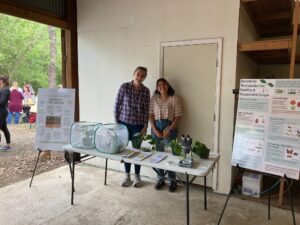
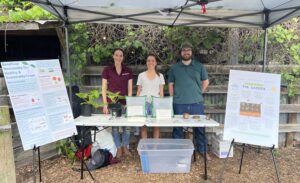
In 2021 and 2022 our lab participated in the Ronin Spring Farm Day event, where we shared an exhibit on biological pest control and sustainable agriculture. Three graduate students and three undergraduate students from my research team participated in coordinating the exhibit and volunteering at the event. In 2021, we met with over 200 members of the local community, including 2 local vegetable producers, who were very receptive to the research. In 2022, we met with close to 400 community members. We prepared and distributed 3 different educational materials/fact sheets on relevant topics, including 1) pests of cucurbit crops, 2) local pollinators, and 3) local natural enemies. We also led an on-farm demonstration of our research.
In 2021-2023, PI Helms presented results from this project in 8 research seminars. She also met with members of the vegetable IPM team from Cornell University to discuss strategies for implementing EPNs for controlling cucurbit pests.
Learning Outcomes
Farmers reported gaining new knowledge about biological pest control and greater confidence in trying these methods
Project Outcomes
Through our project we were able to demonstrate that applying beneficial nematodes can improve crop plant protection and increase yield. Our findings also suggest that targeted beneficial nematode treatments are safe for beneficial arthropods, including pollinators and natural enemy species. Overall, this research suggests that growers can benefit from using nematodes for biological pest control, allowing them to reduce synthetic pesticide inputs while experiencing higher yields.
We recommend that farmers and home gardeners consider using applications of beneficial nematodes as part of their pest management plans.